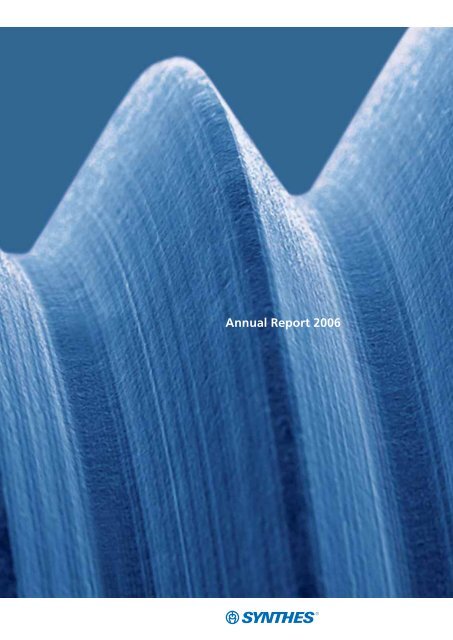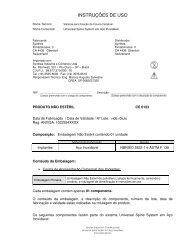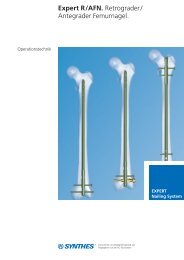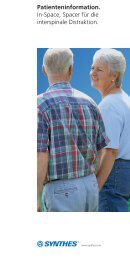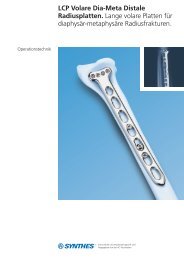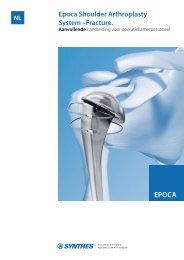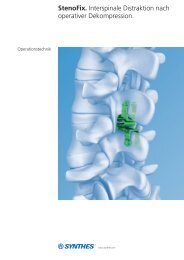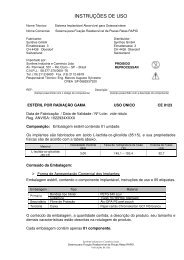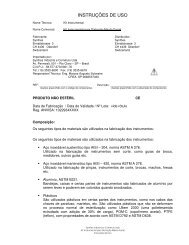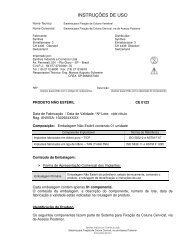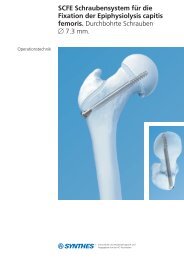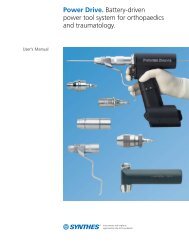Create successful ePaper yourself
Turn your PDF publications into a flip-book with our unique Google optimized e-Paper software.
Annual Report <strong>2006</strong>
Content<br />
Company Profile | 1<br />
Preface | 3<br />
Letter to Shareholders | 4<br />
<strong>Business</strong> Reports | 7<br />
North America | 9<br />
Europe | 11<br />
Asia Pacific | 13<br />
Latin America, Middle East and Africa | 15<br />
Poland | 17<br />
Product Highlights | 19<br />
Trauma. Reamer-Irrigator-Aspirator | 20<br />
Spine. SynFix-LR | 22<br />
Cranio-maxillofacial. Patient Specific Implants | 24<br />
Sustainability | 27<br />
Health, Safety and Environment | 29<br />
Employees | 31<br />
Outlook | 33<br />
Corporate Governance | 35<br />
Financial Review | 53<br />
LCP Locking Screw
Significant Facts<br />
Net sales in US$ million<br />
Operating profit before in-process research<br />
and development (IPR&D) in US$ million<br />
2002<br />
1,017.2<br />
2002<br />
396.2<br />
2003<br />
1,229.0<br />
2003<br />
443.8<br />
2004<br />
1,779.3<br />
2004<br />
504.7<br />
2005<br />
2,078.2<br />
2005<br />
662.2<br />
<strong>2006</strong><br />
2,391.6<br />
<strong>2006</strong><br />
762.6<br />
0 1000 2000 3000<br />
0 300 600 900<br />
Net earnings before IPR&D in US$ million<br />
Free cashflow in US$ million<br />
2002<br />
253.0<br />
2002<br />
209.9<br />
2003<br />
290.1<br />
2003<br />
203.3<br />
2004<br />
323.7<br />
2004<br />
301.1<br />
2005<br />
436.0<br />
2005<br />
337.1<br />
<strong>2006</strong><br />
508.8<br />
<strong>2006</strong><br />
343.6<br />
0 200 400 600<br />
0 100 200 300<br />
Research & development in US$ million<br />
Employee development<br />
24.1%<br />
2002<br />
50.8<br />
2002<br />
3,803<br />
2003<br />
66.2<br />
2003<br />
25.5%<br />
4,290<br />
2004<br />
109.5<br />
2004<br />
6,711<br />
30.7%<br />
2005 114.8<br />
<strong>2006</strong> 125.6<br />
0 50 100 150<br />
2005<br />
<strong>2006</strong><br />
7,627<br />
8,451<br />
26.7%<br />
26.5%<br />
Number of employees at year-end<br />
Sales force (in % of average number of employees)
Consolidated Results<br />
Sales per region in US$ million<br />
1<br />
2<br />
3<br />
4<br />
<strong>2006</strong> % of sales 2005 % of sales<br />
North America 1,525.1 63.8 1,329.2 64.0<br />
Europe 519.1 21.7 445.1 21.4<br />
Asia Pacific 220.1 9.2 197.6 9.5<br />
Rest of world 127.3 5.3 106.3 5.1<br />
<strong>2006</strong><br />
3<br />
2005<br />
4 1<br />
4 1<br />
3<br />
2<br />
2<br />
Margin overview in US$ million<br />
1<br />
2<br />
3<br />
4<br />
<strong>2006</strong> % of sales 2005 % of sales<br />
Gross margin 1,957.9 81.9 1,715.5 82.5<br />
Ebit margin 764.8 32.0 667.3 32.1<br />
Net profit margin 508.8 21.3 436.0 21.0<br />
R&D margin 125.6 5.3 114.8 5.5<br />
1<br />
2<br />
-0.1%<br />
3 637<br />
-0.6%<br />
3<br />
+0.3%<br />
4<br />
-0.2% <strong>2006</strong><br />
2005<br />
Assets – Current assets in US$ million<br />
<strong>2006</strong> % of total 2005 % of total<br />
assets<br />
assets<br />
<strong>2006</strong><br />
2005<br />
1<br />
Current assets 1,286.6 28.3 1,123.0 32.6<br />
5 1<br />
5 1<br />
Assets – Non-current assets in US$ million<br />
4<br />
2<br />
3<br />
4<br />
5<br />
<strong>2006</strong> % of total 2005 % of total<br />
assets<br />
assets<br />
Property, plant & equipment 545.0 12.0 506.2 14.7<br />
Intangible assets 1,743.3 38.3 893.3 26.0<br />
Goodwill 911.6 20.0 853.6 24.8<br />
Other assets 62.8 1.4 64.1 1.9<br />
3<br />
2<br />
4<br />
3<br />
2<br />
Liabilities and equity in US$ million<br />
<strong>2006</strong> % of total 2005 % of total<br />
assets<br />
assets<br />
<strong>2006</strong><br />
2005<br />
1<br />
2<br />
3<br />
4<br />
Current liabilities 672.8 14.8 556.2 16.2<br />
Long-term liabilities 497.8 10.9 496.6 14.4<br />
Retained earnings 1,327.4 29.2 880.8 25.6<br />
Other equity 2,051.3 45.1 1,506.6 43.8<br />
1<br />
2<br />
1<br />
2<br />
3<br />
3<br />
4<br />
4
<strong>Synthes</strong>. Annual Report <strong>2006</strong><br />
Company Profile<br />
<strong>Synthes</strong> is a leading global medical device company. We develop, produce<br />
and market instruments, implants and biomaterials for the surgical<br />
fixation, correction and regeneration of the human skeleton and<br />
its soft tissues. We are represented on every continent and employ<br />
approximately 8,500 people worldwide. We generate revenues of<br />
over US$ 2.3 billion and make a net profit of US$ 509 million.<br />
<strong>Synthes</strong> establishes the foundations for its excellent market position<br />
by continuously developing better solutions. Our goal is to provide<br />
the safest and most advanced implants, instruments and technologies<br />
that ensure reliable operating procedures, rapid recovery and a<br />
pain-free life after surgery. We guarantee high quality, constant innovation<br />
and total concentration on the needs of our customers.<br />
<strong>Synthes</strong> is the world leader in traumatology, ranks among the top<br />
three companies for spinal devices and is at the forefront of the craniomaxillofacial<br />
business. We are an innovative pioneer in the field of<br />
biomaterials such as resorbable implants and bone graft substitutes,<br />
and have become a leader in non-fusion technologies by developing<br />
nucleus and total intervertebral disc replacements.<br />
Working closely together with surgeons in hospitals all over the world,<br />
our product development teams of scientists, engineers and product<br />
managers identify real clinical needs. This provides the basis for developing<br />
products with increased benefits for patients, surgeons and<br />
OR personnel.<br />
The Functional Structure<br />
of Global <strong>Synthes</strong><br />
North America<br />
Asia Pacific Europe Latin America,<br />
Middle East and Africa<br />
Trauma<br />
Spine<br />
Cranio-maxillofacial<br />
Biomaterials<br />
Power Tools<br />
Operations<br />
Operations<br />
Global services: Finance, Human Resources, Information Technology, Legal, Purchasing, Quality, Regulatory Affairs<br />
1
Preface<br />
Expert Tibial Nail<br />
2
<strong>Synthes</strong>. Annual Report <strong>2006</strong><br />
Up Close<br />
While you browse through the pages that follow, we invite<br />
you to take a close look at inspiring shapes and textures,<br />
and hope you will discover many new connections<br />
and impressions. In this annual report we present some<br />
of our products from an unusual perspective – a very<br />
close perspective. At first glance they may appear merely<br />
functional, but under the scanning electron microscope<br />
and the macro lens, ordinary implants and instruments<br />
take on a completely different and abstract form. The<br />
magnified depiction seems almost to become a work of<br />
art with its own aesthetics. Observed at a strong magnification<br />
and from odd angles, familiar products suddenly<br />
become strange objects. The deeper we delve into the<br />
material, the more its qualities change, revealing a surprisingly<br />
artistic aspect which its inventors never intended<br />
to create. While you study our report, you are<br />
invited to guess which products are depicted. At the<br />
bottom of each image you will find the answers to these<br />
little mysteries.<br />
3
Letter to Shareholders<br />
Letter to Shareholders<br />
In <strong>2006</strong> <strong>Synthes</strong> reached important milestones in its history. We signed an agreement with the<br />
AO Foundation concerning the purchase of the <strong>Synthes</strong> brand name, trademark and intellectual property.<br />
In addition, we gained approval for the sale of a new artificial disc, Prodisc-L, in the United States.<br />
Dear shareholders, employees and friends of <strong>Synthes</strong><br />
Once again, <strong>2006</strong> was a very successful year for <strong>Synthes</strong> both operationally<br />
and strategically. We agreed to acquire a number of intellectual<br />
properties from the AO Foundation related to our business.<br />
This transaction resulted in the transfer of all patents, the <strong>Synthes</strong><br />
trademark and the brand name to our company, thereby enhancing<br />
our independence and the financial strength of the AO Foundation.<br />
The longstanding cooperation between <strong>Synthes</strong> and the AO Foundation<br />
will be intensified by a special agreement, which allows the AO<br />
to further expand its regional educational activities and programs for<br />
training surgeons and conducting basic research. <strong>Synthes</strong> will continue<br />
to submit all new products to the Technical Commission of the AO<br />
Foundation for quality assurance and approval.<br />
Another important milestone in <strong>2006</strong> was the FDA approval for <strong>Synthes</strong><br />
to sell Prodisc-L, a newly developed artificial disc, in the US market.<br />
This arthroplasty device is a revolutionary method for treating degenerative<br />
disc disease, and has found high acceptance with key<br />
experts in spinal surgery. Like all new technologies, Prodisc-L will require<br />
some time to penetrate a broader market. We will strive to gain<br />
support from a majority of surgeons and reimbursement parties by<br />
convincing them of the long-term benefit for the patient. We strongly<br />
believe that this treatment of the degenerative disc disease is the<br />
beginning of a basic change in the management of spinal disorders.<br />
Additional innovative developments include the recently launched<br />
Reamer-Irrigator-Aspirator (RIA), described in more detail on page 20,<br />
which will further enhance our position in intramedullary nailing, and<br />
the launch of the antibiotic coated Tibia Nail which will help to substantially<br />
reduce the risk of an expensive and painful infection in open<br />
tibia fractures.<br />
Outstanding operational results worldwide<br />
Sales grew by 15.1% and our operating profits amounted to US$ 763<br />
million, representing an increase of 15.2% versus 2005. We gained<br />
market share in all our businesses, with Trauma once again being the<br />
most important growth engine. Not only is it our largest division, it<br />
also generated the strongest growth rate. The continued success we<br />
experience with our constantly growing Locking Compression Plate<br />
(LCP) portfolio has received strong support from the four Expert Nails<br />
which are now fully known and used in all regional markets.<br />
4
<strong>Synthes</strong>. Annual Report <strong>2006</strong><br />
Vectra Plate<br />
I am very happy with the strong growth performance of <strong>Synthes</strong> Europe.<br />
The local currency growth rate of 15.5% in a well developed<br />
market with hardly any room for price increases clearly indicates that<br />
we were able to substantially gain market share. We have been the<br />
leading company in Trauma for many years, and increasingly can claim<br />
the dominant position in European countries for our Spine and Craniomaxillofacial<br />
businesses. As a worldwide company we are now able<br />
to introduce new products at an accelerated pace and have therefore<br />
gained substantial market share throughout Asia and especially in<br />
Japan, Australia and New Zealand. We are also very pleased with our<br />
increased penetration in the emerging markets of Central and Eastern<br />
Europe.<br />
and offer thousands of training days to surgeons, OR-personnel and<br />
our own staff.<br />
I am grateful to our employees, who have made our company so successful.<br />
I would also like to express my gratitude for our long-standing<br />
and loyal customers. And we thank our shareholders for the confidence<br />
they have shown in our company. We hope you enjoy this<br />
annual report, which takes a close look at the artistic component of<br />
our products.<br />
Human Resources development<br />
At the end of <strong>2006</strong> <strong>Synthes</strong> employed 8,451 people worldwide, and<br />
we created 824 new jobs throughout the year. We offer a large variety<br />
of challenges for qualified and highly motivated individuals seeking<br />
a career in a global company. It is thanks to the day-to-day contribution<br />
of each individual employee that we once again were able to<br />
innovate our product portfolio, strengthen our service to hospitals,<br />
Hansjörg Wyss<br />
Chairman and CEO<br />
5
<strong>Business</strong> Reports<br />
CMF Screwdriver Handle<br />
6
<strong>Synthes</strong>. Annual Report <strong>2006</strong><br />
<strong>Business</strong> Reports<br />
North America | 9<br />
Europe | 11<br />
Asia Pacific | 13<br />
Latin America, Middle East and Africa | 15<br />
Poland | 17<br />
7
<strong>Business</strong> Reports. North America<br />
In North America, all three divisions outperformed<br />
the market. Launches of new products with<br />
true clinical benefits, intensified market presence,<br />
an expanded training portfolio, and added<br />
services for customers contributed to this outstanding<br />
result.<br />
SynFix-LR<br />
8
<strong>Synthes</strong>. Annual Report <strong>2006</strong><br />
<strong>Business</strong> Report. North America<br />
Sustaining a market share of 55% for the Trauma business in an increasingly<br />
competitive environment is a challenging task in itself, but<br />
exceeding market growth rates and gaining further market share can<br />
only be accomplished by an organization in peak condition. <strong>Synthes</strong>’<br />
Trauma business in North America once again outstripped the company’s<br />
average growth in <strong>2006</strong>. We introduced over 40 new products<br />
to the market; ten of these launches had a significant impact on<br />
growth. Most of the major launches were additions to the Locking<br />
Compression Plate (LCP) system, which now consists of 32 product<br />
lines. In intramedullary nailing, the introduction of the Expert Lateral<br />
Femoral Nail (LFN) was the main market launch of the year. The rollout<br />
of the Headless Compression Screw in the subsegment for minifragments<br />
was another important highlight.<br />
Added value for customers due to intensified presence<br />
We further expanded the specialized Trauma sales force in North<br />
America, and at the same time we were able to increase per capita<br />
productivity. It has always been our aim to heighten our presence in<br />
the market and to offer the most outstanding service to our customers.<br />
With an enlarged sales force we are in a position to intensify<br />
our efforts to bring added value to hospitals, be it in the areas of<br />
training, inventory management and technical support during surgeries,<br />
or the optimization of the overall treatment process in complex<br />
cases.<br />
Training courses for surgeons and OR-personnel were once again at<br />
the top of our priority list, and our activities in this field were manifold.<br />
In the fourth quarter of <strong>2006</strong> <strong>Synthes</strong> introduced a training program<br />
that addresses the specific needs of resident surgeons. By the<br />
end of the year over 500 surgeons had already enrolled in the program.<br />
Although Prodisc-L had very little impact on sales in <strong>2006</strong>, <strong>Synthes</strong>’<br />
Spine business still outperformed the market for spinal devices. <strong>Business</strong><br />
was fueled by the introduction of our new pedicle screw system<br />
Pangea, the additional dynamic cervical plating system Vectra-T, the<br />
cervical Axon System, and the Anterior Tension Band. Over a third of<br />
the revenues of the North American Spine division were generated<br />
by products introduced to the market within the last three years.<br />
As in all other businesses, we increased the sales force in Spine. A<br />
great deal of attention was given to enhancing the product knowledge<br />
and selling techniques of our sales personnel in order to cope<br />
with the increasing pressure against higher prices in the healthcare<br />
sector. These measures will also enable our consultants to successfully<br />
promote our innovative products, which continue to address previously<br />
unsolved clinical issues.<br />
Portfolio extension for neurosurgeons<br />
<strong>Synthes</strong>’ North American Cranio-maxillofacial organization is still the<br />
largest in the region and holds a market share of well over 50%. We<br />
have been able to maintain this position by continually launching innovative<br />
products to the market. The Low Profile Neuro System has<br />
been the main growth driver for many years, but recent introductions<br />
such as the Sternal Fixation System, the Patient Specific Implant (see<br />
page 24 in this report), and the PlusDrive System also support this<br />
positive development. In <strong>2006</strong>, <strong>Synthes</strong> focused on a moderate sales<br />
force expansion and on a variety of training activities, both for our<br />
own sales people and for customers throughout North America. The<br />
CMF division concentrated especially on educating surgeons and ORpersonnel<br />
working in the field of neurosurgery, the area in which we<br />
launched the majority of our new CMF products during the past year.<br />
Preparing to take on the arthroplasty market with Prodisc-L<br />
The FDA approval for the launch of the artificial lumbar disc Prodisc-L<br />
to the US market was one of the major events for the Spine division<br />
in <strong>2006</strong>. Since receiving approval, <strong>Synthes</strong> has initiated a controlled<br />
rollout and has provided in-depth training to a significant number of<br />
spine surgeons in how to diagnose suitable patients for total disc replacement<br />
and in how to perform the surgical procedure systematically.<br />
Despite the currently unsettled reimbursement environment for<br />
disc arthroplasty, we view this market as a potentially huge area of<br />
growth. We have therefore focused on positioning ourselves as the<br />
provider of a very high quality product supported by a comprehensive<br />
training program. Accordingly, our main strategy is to generate a<br />
maximum number of excellent patient outcomes in order to build<br />
a basis for long-term success in this new market.<br />
9
<strong>Business</strong> Reports. Europe<br />
In Europe <strong>Synthes</strong> can look back on one of its<br />
most successful years, despite an increasingly difficult<br />
market environment and pressure on prices.<br />
The high growth rate and increased market shares<br />
prove that our long-term investments are<br />
paying off.<br />
AO/ASIF Quick Coupling<br />
10
<strong>Synthes</strong>. Annual Report <strong>2006</strong><br />
<strong>Business</strong> Report. Europe<br />
<strong>2006</strong> was one of the best years for the European business. Sales in<br />
local currency grew by 15.5% and for the first time broke the US$ 500<br />
million mark. The reasons for this positive development are numerous<br />
but can be ascribed mainly to the merger with Mathys. We benefited<br />
from a uniform market in which we could fully leverage our<br />
product portfolio as well as our training, manufacturing and logistics<br />
activities. The investments in the sales force are producing positive<br />
results and our consultants are performing at higher productivity<br />
levels.<br />
Products with true clinical benefits boost growth<br />
But despite these positive results, the market environment in Europe<br />
is difficult. The price increases which the market is willing to accept<br />
hardly compensate for inflation rates. And new product introductions<br />
only lead to higher selling prices if we are able to convince customers<br />
that our innovations offer a substantial clinical benefit compared to<br />
all other existing products for that specific indication. Due to the successful<br />
launch of products that meet surgeons’ and patients’ needs,<br />
<strong>Synthes</strong> significantly outperformed the market and gained market<br />
shares across the board in <strong>2006</strong>. In addition, we experienced strong<br />
growth in Middle and Eastern European countries such as Russia,<br />
Poland and the Czech Republic, where more government funds are<br />
allocated to healthcare and individual purchasing power is increasing.<br />
LCP and Expert Nailing System yield outstanding results<br />
Once again the Locking Compression Plate (LCP) portfolio was a major<br />
growth driver for the European Trauma business. Not only did the<br />
system achieve a higher penetration but we also extended existing<br />
systems and added several new product lines such as a variety of proximal<br />
and distal LCP Tibia Plates, the LCP Olecranon Plate for the elbow,<br />
and the LCP Proximal Femoral Plate, just to mention a few. <strong>Synthes</strong>’<br />
global trauma market share is roughly 46%. In the subsegment<br />
of plates and screws our market share has always been much higher<br />
than that, and in <strong>2006</strong> it rose yet higher.<br />
Unprecedented number of high-impact spine products<br />
In <strong>2006</strong> <strong>Synthes</strong> introduced more high-impact spine products than in<br />
any previous year. Vectra, Vectra-T (two dynamic cervical plates) and<br />
Pangea (lumbar pedicle screw system) are only the most prominent<br />
launches in Europe. With the artificial discs Prodisc-L for the lumbar<br />
spine and Prodisc-C for the cervical spine, <strong>Synthes</strong> has established itself<br />
as European market leader in disc arthroplasty. Further enhancements<br />
to the instrumentation of both discs solidified their position as<br />
the most user-friendly disc devices in this market. Not only has Prodisc<br />
been a success in Europe, but it has also served as a door-opener to<br />
new customers who subsequently switched to <strong>Synthes</strong>’ traditional<br />
spine portfolio.<br />
CMF – market leading position within reach<br />
In Cranio-maxillofacial, <strong>Synthes</strong> is on the verge of becoming the market<br />
leader in Europe. We have further expanded our market share and<br />
have established ourselves in markets in which we previously lacked<br />
a dedicated sales force. Mandible and midface fixation devices are<br />
among the most demanded products. In addition, the Patient Specific<br />
Implant System (PSI), contributed to the growth rate in the high teens.<br />
Increased training for OR-personnel<br />
In <strong>2006</strong> <strong>Synthes</strong> continued to develop its specialized sales forces in<br />
Europe with the goal of supporting OR-personnel both inside and<br />
outside the operating theatre. This support includes on-site training<br />
in the use and maintenance of our products, inventory management,<br />
and generally how to interact with surgeons and nurses in order to<br />
maintain the high level of excellent outcomes achieved using <strong>Synthes</strong><br />
products.<br />
Intramedullary nailing, on the other hand, offers room for further<br />
share gains, despite the fact that <strong>Synthes</strong> is also the market leader in<br />
this area. The introduction of the first nails of the new Expert Nailing<br />
System resulted in a strong growth momentum, and the subsequent<br />
launches across Europe of the remaining nails – namely the Expert<br />
Humerus Nail, the Expert Retrograde/Antegrade Femoral Nail and the<br />
Expert Lateral Femoral Nail – will enhance this development. Additional<br />
new products will support our position in the subsegment of intramedullary<br />
nailing: the Reamer-Irrigator-Aspirator (RIA), the ModAD aiming<br />
device and the antibiotic coatings for the tibia nail are all in the<br />
process of being launched.<br />
11
<strong>Business</strong> Reports. Asia Pacific<br />
The Asia Pacific region consists of numerous<br />
heterogenous markets of which each<br />
demands particular attention and tailored solutions.<br />
<strong>Synthes</strong>’ efforts in addressing issues<br />
individually have already yielded positive results –<br />
particularly in Japan where we now are the<br />
strong number two in Trauma.<br />
Cervical Spine Screw<br />
12
<strong>Synthes</strong>. Annual Report <strong>2006</strong><br />
<strong>Business</strong> Report. Asia Pacific<br />
<strong>2006</strong> was a challenging but successful year for business in Asia Pacific.<br />
In this region management is confronted with a very heterogeneous<br />
group of countries and has to address a number of diverse issues<br />
related to the special characteristics of the individual markets.<br />
Throughout the region <strong>Synthes</strong> invested heavily in educational programs<br />
for surgeons, OR-personnel, and its own sales forces. Together<br />
with the AO, we offered more than 30% additional training days<br />
to surgeons compared to the previous year. Additionally, we installed<br />
training teams in dedicated facilities currently located in Japan, China<br />
and at the regional headquarters in Australia. Despite decreased<br />
prices in Japan and no price increases across the rest of the region,<br />
<strong>Synthes</strong> achieved a local currency growth rate of 14.1%. However,<br />
foreign currency loss of 2.7% negatively impacted the positive results.<br />
Japan – strong growth despite imposed price reductions<br />
Japan accounts for more than 50% of the region’s sales and contributes<br />
an even higher percentage to profits. In <strong>2006</strong>, the market<br />
was affected by government intervention with the tightening of regulatory<br />
requirements for product introductions and the reduction of<br />
reimbursement for orthopedic products, particularly in the trauma business.<br />
Despite a price reduction of more than 4% for trauma products,<br />
we achieved a double-digit increase in revenues in this sector<br />
due to an excellent growth in volume. <strong>Synthes</strong> now holds a firm number<br />
two position in the Trauma segment with a market share of more<br />
than 20%.<br />
<strong>Synthes</strong> also achieved very strong results in Cranio-maxillofacial and<br />
even stronger ones in Spine, substantially outperforming the Japanese<br />
market in both segments. Nevertheless, the market shares in CMF<br />
and Spine remain far below the average <strong>Synthes</strong> enjoys in the rest of<br />
the world. A lot of work therefore remains to be done to achieve the<br />
growth potential in these market segments. The Japanese version of<br />
the Proximal Femur Nail (PFNA) is the first product especially designed<br />
to cater for the specific geometry of an Asian femur. The concept has<br />
been very well received by surgeons in the region and it will launch<br />
in the first quarter of 2007.<br />
products that generated sales in <strong>2006</strong>. The Locking Compression<br />
Plate (LCP) system, which has become the established standard treatment<br />
for fractures of osteoporotic bone or complex fractures, and<br />
spinal products such as Pangea (a pedicle screw system), SynFix-LR<br />
and Vectra (a dynamic cervical plate) have been significantly contributing<br />
to growth since their launch during the course of the year.<br />
China, India and other Asian countries –<br />
long-term investments and educational efforts<br />
In terms of operative treatment of fractures and spinal diseases, China<br />
and India are still underdeveloped. But both are overpopulated<br />
countries with an enormous long-term growth reservoir. The major<br />
challenge in these areas is to establish a broad acceptance for our<br />
high quality products and for the AO philosophy of bone fracture<br />
management. <strong>Synthes</strong> has its own offices and sales forces in these<br />
two countries as well as in Indonesia, Korea and Taiwan. In all other<br />
Asian countries <strong>Synthes</strong> is represented by distributors.<br />
It will require strong educational efforts to establish our organization<br />
in those countries. We are confident that the manifold educational<br />
activities of the AO Foundation will help us achieve this goal. Investing<br />
in the development of these markets is a long-term endeavor. We<br />
are positive that our undertakings will not only strengthen our leading<br />
position as a foreign provider of outstanding orthopedic implants,<br />
but also support the emergence of an improved healthcare system<br />
for the benefit of patients, surgeons and the health authorities.<br />
Australia, New Zealand, Hong Kong, Malaysia<br />
and Singapore – successful launches<br />
These five countries are in many ways comparable to North America<br />
and Europe in factors such as the level of educational background,<br />
the regulatory environment, and the availability of reimbursement for<br />
healthcare services and medical devices. In all these countries <strong>Synthes</strong><br />
has a direct presence, with our own subsidiaries and dedicated<br />
sales forces. Although the regulatory requirements are becoming<br />
more stringent, we were successful in introducing a number of new<br />
13
<strong>Business</strong> Reports. Latin America, Middle East and Africa<br />
The market in Latin American, the Middle East<br />
and Africa is steadily growing as fractures<br />
are increasingly treated with operative methods.<br />
<strong>Synthes</strong>’ operations in these regions reflect<br />
this upward trend: the number of Latin American<br />
subsidiaries was further increased and distributors<br />
expanded their sales forces in Middle East<br />
and Africa.<br />
Titanium Elastic Nails<br />
14
<strong>Synthes</strong>. Annual Report <strong>2006</strong><br />
<strong>Business</strong> Report. Latin America, Middle East and Africa<br />
During <strong>2006</strong>, Latin America contributed the strongest growth performance<br />
in the company, with a local currency growth rate in the high<br />
twenties that was further supported by a foreign exchange gain. The<br />
Latin American business accounted for more than 3.4% of overall corporate<br />
revenues, compared to approximately 3.0% in 2005.<br />
A new subsidiary in Costa Rica<br />
<strong>Synthes</strong> owns subsidiaries in Argentina, Brazil, Colombia, Mexico, and<br />
Peru, and added a sixth subsidiary by acquiring the existing distributor<br />
in Costa Rica in late <strong>2006</strong>. Operations were strengthened with the<br />
establishment of additional <strong>Synthes</strong> offices in various cities in Brazil,<br />
Mexico and Peru. The fact that Brazil and Colombia alone accounted<br />
for more than 50% of all revenues in Latin America indicates that this<br />
region still has great potential for future growth.<br />
sections “AO Middle East” and “AOSpine Middle East” will help to<br />
enforce our leadership in Trauma and further improve our market position<br />
in the Spine and Cranio-maxillofacial segments. Indeed, the<br />
performance of the two latter businesses was very positive in <strong>2006</strong>;<br />
they were the main contributors to the double-digit growth rate in<br />
the region.<br />
Expanded sales forces in MEA hold competition at bay<br />
We further expanded our sales force in South Africa, the only directly<br />
served country in the region, and successfully encouraged our distributors<br />
in all other countries to increase the number of dedicated<br />
sales personnel as well. Due to this strong presence our high quality<br />
products and service strategy prevailed over numerous local and international<br />
competitors.<br />
The Locking Compression Plate (LCP) system remains the main growth<br />
contributor for the Trauma business and most LCP product lines are<br />
now available throughout the region. Many new LCP specialty plates<br />
such as the Distal Femur Plate and the Compact Hand System were<br />
introduced in <strong>2006</strong>. In Spine, PEEK cages and biomaterials contributed<br />
most significantly to growth. Our Cranio-maxillofacial business established<br />
new fields of application, particularly in the neuro market<br />
with the Patient Specific Implants and our unique VEPTR system, offering<br />
customers unprecedented solutions.<br />
During <strong>2006</strong> we substantially increased the penetration of LCP in MEA.<br />
In Spine we experienced a high growth impact from the Universal<br />
Spine System (USS II) and the pedicle screw system Click’X. Finally,<br />
we were able to make customers aware that <strong>Synthes</strong> is also a significant<br />
player in the Cranio-maxillofacial market, where we doubled our<br />
sales in <strong>2006</strong> and started to promote the latest product systems which<br />
up to now have only been available in highly developed markets.<br />
Training as an important pillar of success<br />
World-class training provided by <strong>Synthes</strong> and strong cooperation with<br />
the regional AO organization are crucial for sustainable success. This<br />
is true for all markets, but in Latin America, education and training<br />
play an even greater role as more and more fractures are treated surgically.<br />
<strong>Synthes</strong> has created a new training structure by increasing the<br />
number of dedicated trainers to continually improve the specialized<br />
knowledge of a continually growing sales force. For surgeons and ORpersonnel,<br />
AO Latin America continues to offer an increasing number<br />
of AO courses in all specialties.<br />
Important AO activities in Middle East and Africa<br />
As in Latin America, in the Middle East and Africa (MEA) the most<br />
effective path to sustainable success is through consistent and medically<br />
aligned education. In <strong>2006</strong> <strong>Synthes</strong> continued to give high priority<br />
to the strengthening of its training and educational efforts in<br />
the region.<br />
<strong>Synthes</strong> is particularly grateful for the efforts of the AO Foundation<br />
in establishing regional organizations in MEA for Trauma and Spine<br />
and supports the AO’s endeavors in every way possible. The new AO<br />
15
<strong>Business</strong> Reports. Poland<br />
Poland is a growing market for medical devices,<br />
and entry into the European Union in<br />
2004 has considerably reinforced this trend.<br />
<strong>Synthes</strong> seized the opportunity of expanding<br />
into this newly emerging healthcare<br />
market several years ago, and we have<br />
been making excellent progress ever since.<br />
Expert Humeral Nail<br />
16
<strong>Synthes</strong>. Annual Report <strong>2006</strong><br />
Emerging Markets. Poland<br />
With roughly 37 million inhabitants, Poland is one of the larger European<br />
economies. When the European Union was expanded eastward<br />
in 2004, restrictions to trade with the new member state Poland<br />
were relaxed, considerably increasing our sales opportunities in this<br />
less-developed market for medical devices. Entry to the EU has proven<br />
to be highly beneficial for the Polish healthcare sector, with positive<br />
changes and developments in medical treatment patterns, the provision<br />
of healthcare, and the availability of funding. These encouraging<br />
trends are being reinforced by government initiatives to modernize<br />
and rationalize the healthcare system and to increase the financial<br />
resources in this sector by an average of 6–7% annually.<br />
<strong>Synthes</strong> is in third place in the Polish market for spinal products. The<br />
artificial discs Prodisc-L and Prodisc-C have been introduced, and high<br />
surgeon interest in these new devices has resulted in growing sales.<br />
Besides the Prodisc systems, sales growth in the Spine segment has<br />
been driven by the cervical intervertebral spacer Cervios and the second<br />
generation of the Universal Spine System (USSII).<br />
In the Cranio-maxillofacial business, <strong>Synthes</strong> is the market leader in<br />
Poland. Products generating strong sales include FlapFix for the fixation<br />
of cranial bone flaps, the Compact MF System and our bone graft<br />
substitute Norian.<br />
The Polish orthopedic market is currently estimated at approximately<br />
US$ 18 million, with annual growth rates in the teens. <strong>Synthes</strong> established<br />
its own subsidiary in Poland in 2003 and has invested heavily<br />
ever since to build a strong position in the growing Polish market.<br />
<strong>Synthes</strong> increased its local sales force by almost 40% in <strong>2006</strong> alone.<br />
Strategic positioning through high service levels<br />
Pricing competition poses a key challenge in Poland, as local companies<br />
with low-cost copies have a strong presence in the market. We<br />
are striving to position ourselves as the company of choice in the Polish<br />
orthopedic market by offering customers the best service level in<br />
the industry. <strong>Synthes</strong> Poland operates with dedicated sales teams that<br />
focus on specific market segments, with separate sales forces to call<br />
on traumatology, spine and cranio-maxillofacial surgeons. This means<br />
our customers can rely on <strong>Synthes</strong> representatives who have in-depth<br />
knowledge of their specialty and its specific needs. As part of their<br />
service, <strong>Synthes</strong> consultants spend around 25% of their time in the<br />
operating theatre, ensuring that <strong>Synthes</strong> products are applied appropriately<br />
and that the surgical procedures in the operating room go<br />
smoothly. Comprehensive medical training activities complete our<br />
outstanding service portfolio, as we organize and conduct on-site<br />
training workshops for surgeons and OR-personnel in numerous local<br />
hospitals on a regular basis.<br />
Strong interest in innovative technologies<br />
As the number two company in the trauma market, <strong>Synthes</strong> is competing<br />
successfully with local and international competitors. Nailing<br />
and plating techniques are equally popular among Polish surgeons.<br />
Our Locking Compression Plate (LCP) system enjoys very high acceptance<br />
and has substantially replaced the older methods of plating. In<br />
the subsegment of intramedullary nailing, new products such as the<br />
PFNA and the Expert Tibial Nail have been extremely well accepted<br />
by the surgical community in Poland.<br />
17
Product Highlights<br />
MatrixNEURO Mesh Plate<br />
18
<strong>Synthes</strong>. Annual Report <strong>2006</strong><br />
Product Highlights<br />
Trauma. Reamer-Irrigator-Aspirator | 20<br />
Spine. SynFix-LR | 22<br />
Cranio-maxillofacial. Patient Specific Implants | 24<br />
19
Product Highlights. Trauma<br />
Trauma. RIA – Reamer-Irrigator-Aspirator<br />
Intramedullary nailing is one of the most successful treatment methods in trauma. This method requires the<br />
expansion of the bone’s medullary canal by means of reaming. With RIA, <strong>Synthes</strong> provides a device<br />
which makes the reaming procedure easier, faster and safer. As an added benefit, RIA can be used for harvesting<br />
autologous bone.<br />
Presently fractures of the long bones, particularly the femur and tibia,<br />
are routinely treated by placing an intramedullary nail into the bone’s<br />
medullary canal. The implant serves as a substitute load-bearing column<br />
until healing occurs. Since the introduction of this technique by<br />
Gerhard Küntscher in the 1940s, it has evolved to become one of the<br />
most successful treatment methods in orthopedic trauma surgery. Intramedullary<br />
nailing allows the quick remobilization of the patient.<br />
This is important in avoiding the serious complications that were common<br />
with the conservative management of fractures by means of<br />
traction and prolonged bed rest.<br />
Preparing the bone for implantation<br />
However, despite the undoubted benefits of the procedure, a risk of<br />
complications remains. The center of long bones is filled with fat<br />
which can be displaced into the venous system when the nail is placed<br />
into the canal. This problem can be compounded if the intramedullary<br />
space needs to be increased in diameter to accommodate a larger,<br />
stronger nail than could be placed in the patient’s natural canal. In<br />
order to create a greater diameter inside the bone, the surgeon introduces<br />
drills of increasing size until the canal has been expanded<br />
sufficiently. This process is known as reaming.<br />
Reaming produces pressure which forces marrow fat into the vascular<br />
system. In most cases the consequent embolic debris is tolerated,<br />
but it is known, on occasion, to provoke respiratory and cerebral complications<br />
with adverse consequences ranging from mild lung problems<br />
to, in extreme instances, death. The risk of such complications is<br />
increased in polytrauma patients needing placement of multiple nails,<br />
or patients with cancer who need a nail to prevent a tumor-weakened<br />
bone from fracturing.<br />
create a slurry of cut particles, and then vacuum it away. And, unlike<br />
the inefficient original reaming systems, RIA increases the diameter<br />
in one pass down the bone instead of requiring time-consuming multiple<br />
passes and numerous exchanges of cutting heads. This saves<br />
costly operating room time and provides an easier technique. And<br />
because the cutting surfaces are constantly cooled by irrigation, the<br />
complication of thermal damage to the bone is avoided.<br />
New method for bone harvesting<br />
Being able to enter the canal of the bone safely, without the risk of<br />
complications, has resulted in an entirely novel application for RIA.<br />
Often bone needs to be transplanted from one area, most commonly<br />
the pelvis or iliac crest, to a place where bone is missing or will not<br />
heal. This is known as autograft. Unfortunately, in some cases the<br />
amount of bone needed for transplanting is not available from the<br />
usual harvest sites. This presents a treatment quandary: how to find<br />
the extra bone needed? RIA provides an answer by unlocking an entirely<br />
new source of autograft – the rich reamings of the bone marrow<br />
from the femur or tibia.<br />
With RIA <strong>Synthes</strong> has once again proven its dedication to developing<br />
solutions to important clinical problems. The pursuit of better treatments<br />
is a sustaining mission and one that constantly yields new opportunities.<br />
RIA is poised to open new areas of discovery that result<br />
from this philosophy. But that is another story – one of many which<br />
will undoubtedly result from this truly unique product.<br />
Risks eliminated with RIA<br />
<strong>Synthes</strong> has long been in pursuit of a solution to this complex but important<br />
clinical dilemma. With RIA, the Reamer-Irrigator-Aspirator,<br />
<strong>Synthes</strong> presents a new reaming device which allows surgeons to increase<br />
the canal diameter of the bone without creating pressure,<br />
thereby eliminating the risk of embolization. RIA creates a negative<br />
pressure within the bone, enabling surgeons simultaneously to ream,<br />
20
<strong>Synthes</strong>. Annual Report <strong>2006</strong><br />
Patient story | The young man<br />
was a belt-restrained back-seat passenger<br />
involved in a motor vehicle<br />
accident. He sustained life-threatening<br />
injuries which included fractures<br />
of femurs, a tibia and a forearm. Surgeons<br />
at the University of Florida/Jacksonville<br />
routinely use RIA and<br />
it was ideally suited for management<br />
of this severely injured patient.<br />
Now, seven months after the injury,<br />
his fractures are healed and he<br />
has recovered.<br />
Pre-operative<br />
Post-operative<br />
21
Product Highlights. Spine<br />
Spine. SynFix-LR<br />
SynFix-LR is an innovative device for the fusion of the lumbar spine. As this implant is inserted and fixated<br />
from the front, the delicate back muscles are not affected and patients recover more rapidly. And because only<br />
one surgical approach is necessary, the procedure is more efficient, saving time and costs.<br />
It is well established that at least 8 out of 10 people experience a significant<br />
and disabling episode of back pain at some stage in their life.<br />
These episodes are likely to occur between the ages of 30 and 50,<br />
the most productive period of most people's lives. As we get older,<br />
certain biochemical and structural changes occur in our intervertebral<br />
discs, which can cause pain. Symptoms generally settle spontaneously<br />
within 6 to 12 weeks, but in some cases symptoms persist<br />
and result in considerable limitations affecting work and recreational<br />
and domestic activities.<br />
Approximately one percent of this patient group with persistent and<br />
debilitating pain undergoes surgery to relieve the symptoms. And of<br />
these operated patients around 10 percent are found to have localized<br />
mechanical pain or pain originating from the intervertebral disc<br />
and subsequently undergo a spinal fusion. This involves removing the<br />
pain-generating disc and placing a vertebral spacer between the adjacent<br />
vertebral bodies. The affected segment is additionally fixated<br />
by posterior pedicle screws combined with rods. This requires more<br />
than one incision for accessing the spine from different angles (also<br />
known as 360° fusion).<br />
SynFix-LR stand-alone solution: single<br />
approach from anterior only<br />
Less invasive surgery – faster recovery<br />
360° degree fusion: two approaches<br />
from anterior and posterior<br />
Since SynFix-LR is inserted anteriorly, the posterior muscular structures<br />
are preserved and surgical morbidity associated with posteriorly<br />
instrumented lumbar spine fusion surgery is eliminated. Additionally,<br />
SynFix-LR does not have any overlaying profile on the anterior spinal<br />
column. The postoperative risk of damaging vessels and soft tissue is<br />
therefore eliminated. As a result, patients can be mobilized earlier<br />
and leave hospital sooner, reducing expenses for the hospital stay.<br />
Opening up new options in spinal fusion<br />
Most implant devices require a posterior approach – that is, the surgical<br />
procedure is performed from the back. Posterior approaches<br />
involve cutting through lumbar muscles which are important in maintaining<br />
an upright posture and supporting the spine during day-today<br />
activities. The muscles can take a long time to recover, and the<br />
disruption to their normal mechanics can lead to complications for<br />
quite some time after the operation. <strong>Synthes</strong> has developed a device<br />
that can be applied from the front (anteriorly) by means of a less invasive,<br />
muscle-sparing approach. SynFix-LR consists of a radiolucent<br />
cage and an integrated plate which is fixated with diverging locking<br />
screws for superior stability and pull-out resistance. Together, the fixation<br />
plate and the locking screws act as a tension band. Biomechanical<br />
tests have demonstrated that SynFix-LR offers stability comparable<br />
to that of a cage combined with posterior pedicle screws in flexion,<br />
extension and lateral bending, and is superior in axial rotation.<br />
SynFix-LR requires only a single anterior approach to restore the disc<br />
height and lordotic angulation and fixate the implant. Moreover, Syn-<br />
Fix-LR is a stand-alone device, so additional fixation devices for stabilizing<br />
the affected spine segment are not necessary. Consequently,<br />
surgery time is considerably shorter than in methods involving cages<br />
applied in combination with pedicle screws and rods. Less time in the<br />
operating theatre means a direct reduction of OR-related and staff<br />
costs.<br />
22
<strong>Synthes</strong>. Annual Report <strong>2006</strong><br />
Patient story | This 32-year-old<br />
Australian mother of two children<br />
suffered from increasing back<br />
and leg pain. At first, she opted for<br />
conservative treatment, but after<br />
a year she could no longer tolerate<br />
the pain and the limitations to<br />
her domestic activities. Still, she did<br />
not like the idea of having ”nuts<br />
and bolts” put in her back. When<br />
she heard of the new SynFix-LR<br />
device, she was so convinced that it<br />
was the solution that she decided<br />
to wait another 6 months until the<br />
implant was available.<br />
She was one of the first patients<br />
worldwide to be treated with<br />
SynFix-LR by Dr. C. Cain in Adelaide.<br />
The surgery relieved her of her<br />
back and leg pain almost immediately.<br />
Today, over two years since she<br />
underwent this life-changing surgery,<br />
she can care for her family<br />
without any physical limitations.<br />
Pre-operative procedure to identify<br />
disc damage<br />
After treatment with SynFix-LR<br />
23
Product Highlights. Cranio-maxillofacial.<br />
Cranio-maxillofacial. Patient Specific Implants<br />
In cranioplasty, a satisfying aesthetic result is essential. <strong>Synthes</strong> Patient Specific Implants are custom-designed<br />
implants for the treatment of skull defects and deformities. Because the implants are derived from the patient’s<br />
CT data, excellent reconstructive results are achieved.<br />
Cranioplasty, the surgical repair of defects or deformities of the skull,<br />
is a challenging field. Cranioplasties can treat a variety of conditions<br />
ranging from head trauma to the removal of a tumor, with the goal<br />
of achieving full functionality and acceptable cosmesis. The challenge<br />
for craniofacial surgeons and neurosurgeons alike is to restore the<br />
skull completely using an implantable material and a surgical technique<br />
that minimize post-operative complications. Ideally, the material<br />
should mimic the properties of craniofacial or cranial bone in terms<br />
of strength, infection resistance and fracture resistance to name just<br />
a few.<br />
3-D model derived from CT scan data PSI custom made to fit defect<br />
Previous solutions with drawbacks<br />
There is currently a multitude of materials surgeons can choose from<br />
for treating skull defects or deformities, including autogenous bone,<br />
metals and alloplastics. Autogenous bone grafting, where the patient’s<br />
own bone is used, has long been the standard in reconstructing the<br />
craniofacial skeleton. However, this method is often associated with<br />
significant resorption and is prone to high levels of infection. Metals,<br />
mainly titanium and titanium alloys, offer high strength characteristics<br />
relative to cranial bone and are unlikely to harbor infection, but<br />
they are not easily contoured to match the patient’s anatomic features,<br />
especially for larger defects. Alloplastics, or moldable plastics,<br />
are popular for their adaptability, but they are prone to infection, cannot<br />
always be molded easily for large defects, and give off tremendous<br />
heat during the application process.<br />
Innovative, custom-designed implant<br />
With the introduction of Patient Specific Implants (PSI) <strong>Synthes</strong> offers<br />
the solution to many of the challenges associated with cranioplasty.<br />
PSIs are implants that are custom-designed for each patient and replace<br />
bony voids in the cranial and craniofacial skeleton. Each implant<br />
is designed using a 3D computer-aided design (CAD) model derived<br />
from the patient’s CT scan and is approved by the surgeon prior to<br />
production in order to ensure a high-quality final product. The featured<br />
benefits of this product compared to the conventional treatment<br />
options include a better anatomic fit and reduction in operating<br />
time.<br />
<strong>Synthes</strong> offers two biocompatible material options for PSIs, PEEK Optima-LT<br />
and commercially pure titanium. Both are non-porous materials<br />
and neither is known to harbor infection. PEEK Optima-LT has<br />
bone-like properties in terms of strength and stiffness and is the material<br />
of choice for <strong>Synthes</strong> surgeons. This lightweight plastic offers<br />
no limitations in plating orientation or location and can, if necessary,<br />
be modified in shape at the time of the surgical procedure. Implants<br />
made from titanium have ultra-high strength as compared to cranial<br />
and craniofacial bone. These metallic implants require predetermined<br />
machine screw locations for the attachment of plates and cannot be<br />
modified intraoperatively.<br />
A strong solution for aesthetic results<br />
One of the main advantages of these custom implants is that they<br />
achieve the intended corrective result while minimizing operating<br />
time. Moreover, post-operative complications are reduced and even<br />
prevented by using proven biocompatible materials such as PEEK and<br />
titanium. Together, these benefits make PSIs a strong solution: they<br />
reduce medical costs, facilitate a rapid recovery, and – most importantly<br />
– fully restore the patient’s anatomical cosmesis and functionality.<br />
24
<strong>Synthes</strong>. Annual Report <strong>2006</strong><br />
Patient story | Diagnosed with an<br />
intracranial tumor, this 42-yearold<br />
man decided to have it surgically<br />
removed. The surgeon resected<br />
the tumor, replaced the native bone<br />
flap and fixated it with plates<br />
and screws. Due to intracranial swelling,<br />
the patient suffered from a<br />
seizure two years later and the bone<br />
flap and hardware were permanently<br />
explanted. During his recovery,<br />
the CT scan was evaluated for a<br />
<strong>Synthes</strong> Patient Specific Implant. Later<br />
that year, the patient had a cranio-<br />
plasty in which a PSI made of PEEK<br />
was implanted. Extremely happy<br />
with the result, he has healed well and<br />
is back to normal everyday life.<br />
After removal of native bone flap<br />
2 months after treatment<br />
25
Sustainability<br />
Reduction Foreceps<br />
26
<strong>Synthes</strong>. Annual Report <strong>2006</strong><br />
Sustainability<br />
Health, Safety and Environment | 29<br />
Employees | 31<br />
Outlook | 33<br />
27
Sustainability. Health, Safety and Environment<br />
Quality management is a top priority at <strong>Synthes</strong>.<br />
We proactively implement measures to improve workplace<br />
safety and ensure the health of our employees.<br />
We also monitor our environmental performance<br />
and consistently strive to conserve resources and<br />
reduce waste.<br />
Humerus Block<br />
28
<strong>Synthes</strong>. Annual Report <strong>2006</strong><br />
Sustainability. Health, Safety and Environment<br />
As a manufacturer of medical devices we are required to comply with<br />
a number of environmental and safety legislations set out by the countries<br />
in which we operate. In the USA, <strong>Synthes</strong> continues to strive to<br />
exceed all USA Occupational Health and Safety Administration (OSHA)<br />
and Environmental Protection Agency (EPA) requirements through<br />
best-practice policies for maintaining the safety of all employees<br />
and for protecting the environment. In Europe we comply with ISO<br />
9001:2000 and ISO 13485:2003 for quality management and ISO<br />
14001:2004 for safety and environmental issues.<br />
Preventive measures and training<br />
programs for workplace safety<br />
<strong>Synthes</strong> is totally committed to providing a safe working environment<br />
in the interest of the health of its employees. We provide numerous<br />
tools to assist in manual tasks with respect to weight, danger of injury<br />
and repetitiveness of tasks, and in handling hazardous materials.<br />
All our machines for milling, drilling or grinding are properly secured<br />
in order to prevent any kind of misuse that might endanger health.<br />
All these measures are complemented by a variety of regularly scheduled<br />
safety training programs which are mandatory for all affected<br />
employees. In all our production plants we provide the equipment<br />
necessary to protect our employees from excessive noise levels, vibrating<br />
tools or chippings which could imperil their eyes or other organs.<br />
Finally, all types of adverse incidents are reported and tracked,<br />
providing a system for continuous improvement of health and safety<br />
measures at each workplace at <strong>Synthes</strong>.<br />
Commitment to minimizing environmental impact<br />
<strong>Synthes</strong> continuously assesses the environmental impact of its operations.<br />
During the construction of the new headquarters in West Chester,<br />
Pennsylvania, for example, we paid special attention to energy<br />
efficiency and waste reduction by utilizing environmentally-friendly<br />
equipment and fixtures. We will also consider further ecological issues<br />
when planning the construction of the new office building in<br />
Solothurn, Switzerland, and the expansion of our manufacturing facilities<br />
in Raron, Switzerland.<br />
Given the nature of our manufacturing processes, we are fortunate<br />
that our operations have minimal impact on the environment. Nevertheless,<br />
we are committed to continuously improving our environmental<br />
performance by ensuring that we use fewer resources and<br />
produce less waste while manufacturing more and more products.<br />
Whenever possible, we reduce the number of chemicals involved in<br />
our processes, and select the most environmentally-friendly and least<br />
harmful products for the benefit of our employees and the environment.<br />
In addition, we seek to reduce pollution and emissions by optimizing<br />
the use of raw materials and other supplies, such as cooling<br />
liquids and lubrication solvents, and, where possible, utilizing biodegradable<br />
materials.<br />
29
Sustainability. Employees<br />
Our success and strength depends on the quality<br />
and commitment of our employees. We strive to be<br />
the employer of choice, to attract and retain the<br />
best people in all areas of operation. At <strong>Synthes</strong> employees<br />
can pursue a career full of potential by<br />
taking on challenging tasks, accepting international<br />
assignments and participating in numerous training<br />
opportunities.<br />
Screw Rack with LCP Locking Screws<br />
30
<strong>Synthes</strong>. Annual Report <strong>2006</strong><br />
Sustainability. Employees<br />
In <strong>2006</strong> <strong>Synthes</strong> continued its successful development and created<br />
824 new jobs across the globe, mainly in production and sales. As a<br />
growing company we rely on recruiting new employees through various<br />
channels. For example, in the United States we successfully run<br />
a cooperative program with Drexel University in Philadelphia. Students<br />
from this college spend six months working at <strong>Synthes</strong> as part<br />
of their credit hours towards their engineering degree. The students<br />
profit from gaining practical experiences in the field of product development,<br />
and <strong>Synthes</strong> has been able to attract highly talented students<br />
who on occasions have accepted full time positions upon the<br />
completion of their degree.<br />
Performance Management System<br />
<strong>Synthes</strong> has introduced a Performance Management System geared<br />
towards the company’s various peer groups. Peer groups are organizational<br />
groups whose tasks and goals are comparable. With the new<br />
Performance Management System employees go through an appraisal<br />
review process that covers the performance features and assessment<br />
criteria characteristic for their particular peer group. In this way,<br />
the strengths and areas for development identified during the appraisal<br />
review can result in a stronger contribution to the overall performance<br />
of each individual peer group.<br />
change characteristic of a rapidly growing and highly innovative company.<br />
We are fortunate to be able to count on employees who exhibit<br />
great dedication and motivation and who are prepared to continuously<br />
develop and acquire additional skills to excel in new situations<br />
and challenges.<br />
Following the merger and standardization of our initial training and<br />
continuing training program, we further optimized and expanded the<br />
training portfolio in <strong>2006</strong>. The basis for this work was partly the performance<br />
management findings, and partly the needs identified from<br />
current change management processes and operative requirements.<br />
One of the major highlights was the design and introduction of a special<br />
training course for our product development process. Highly <strong>Synthes</strong>-specific<br />
specialist training courses in the field of product engineering<br />
and production were developed on a global level with experts<br />
from the USA and Europe. In this way, we ensure that <strong>Synthes</strong> employees<br />
around the world are receiving the same practically-oriented<br />
training content.<br />
Corporate Compliance Program<br />
<strong>Synthes</strong> is dedicated to maintaining the highest levels of professional<br />
and ethical standards in the industry. To support our efforts we have<br />
continued the development of our global corporate compliance program.<br />
Our compliance program is overseen by the Audit Committee<br />
of the Board of Directors, is lead by the Chief Compliance Officer, and<br />
is supported by management and staff across the company. The program<br />
is structured to satisfy government and industry standards,<br />
while providing the Board of Directors with effective mechanisms to<br />
monitor and address the legal and ethical compliance of our business<br />
operations. To achieve these goals, the program strives to ensure that<br />
our employees and business partners receive appropriate and clear<br />
guidance and instruction on our policies and practices regarding legal<br />
and ethical compliance. Moreover, we implement measures to prevent<br />
and address any misconduct, and any waste or abuse of our assets,<br />
as well as to foster a consistent culture of ethics and compliance<br />
across the company. In doing so, we strive to strengthen our business<br />
operations, to enhance our reputation for integrity, and to minimize<br />
the risks and costs associated with unethical or illegal conduct.<br />
Continuous training and development<br />
We believe as an employer we have the responsibility of supporting<br />
our employees in dealing with the demanding climate of constant<br />
31
Sustainability. Outlook<br />
For the coming year <strong>Synthes</strong>’ main objectives are<br />
to maintain and increase market shares across<br />
the globe and achieve double-digit sales growth in<br />
the teens. We are confident that with our full<br />
product pipeline we are well prepared to advance<br />
the company’s sustainable development in the<br />
long term.<br />
Cable System<br />
32
<strong>Synthes</strong>. Annual Report <strong>2006</strong><br />
Sustainability. Outlook<br />
Never in its history has <strong>Synthes</strong> achieved less than 10% organic sales<br />
growth. We do not expect 2007 to be any different.<br />
Focus on high potential products<br />
Many demanding tasks lie ahead in the different business areas. Trauma<br />
North America currently has a full and exciting product pipeline.<br />
Some of these products, which mostly build on core concepts such<br />
as the Locking Compression Plate (LCP) system, will be introduced to<br />
the market in 2007, while others will continue to mature during the<br />
course of the year. We will strive to maintain our leading market position<br />
in Trauma, and see room to further increase our market share<br />
in the subsegment of intramedullary nailing as well as in the field of<br />
specialty LCP plates.<br />
Our Spine division will focus on the successful continuation of the<br />
Prodisc-L introduction in the US, which will depend highly on achieving<br />
excellent clinical outcomes as well as on the relaxation of the tight<br />
reimbursement policies for this type of device. In addition, we will<br />
work diligently to obtain a timely premarket approval (PMA) from the<br />
FDA for our cervical artificial disc, the Prodisc-C. With these products<br />
and many other innovative devices in virtually every product category,<br />
we are confident that we will maintain or increase share in the various<br />
segments of the spine market.<br />
Potential for increasing market shares<br />
In Europe, <strong>Synthes</strong> has already benefited from being able to operate<br />
uniformly in all its markets. In countries where we assumed responsibilities<br />
from Mathys three years ago, we have subsequently established<br />
qualified and specialized sales forces. However, our market<br />
shares in these countries, particularly in the areas of Spine and Craniomaxillofacial,<br />
do not yet compare to those in countries in which <strong>Synthes</strong><br />
has been active for a longer period of time. Thus, we expect to<br />
see further momentum for improvement of market share as well as<br />
a per capita productivity increase in these newer European markets.<br />
In Central and Eastern Europe, where we started from a very low base<br />
a few years ago, we are experiencing growth rates that are well above<br />
average, and expect this development to continue in 2007.<br />
prices by generating even more volume growth. Despite some uncertain<br />
external factors, we are confident that we will continue our competitive<br />
pace in these markets with our current product offering. In<br />
addition, the new product approval pipelines look strong, particularly<br />
for spinal implants. We see definite potential for increasing our<br />
share in the Spine and Cranio-maxillofacial markets across the entire<br />
region. We also believe there is a great deal of potential for further<br />
expanding our position in the Trauma business segment. Educational<br />
activities throughout Asia Pacific will continue to be a top priority:<br />
we currently have dedicated training facilities in Japan, China and at<br />
our headquarters in Australia, and we plan to establish a further training<br />
center in India during the coming year.<br />
As for the rest of world, we expect the successful performances in<br />
Latin America and in the Middle East and Africa to continue. Both<br />
these regions offer solid volume growth potential for 2007. We also<br />
believe it is important to continue to expand our sales force presence<br />
and increase our training activities in these regions, often in cooperation<br />
with the AO Foundation.<br />
Focus on sustainable growth<br />
<strong>Synthes</strong>’ primary goal is to maintain a low double-digit sales growth<br />
rate; we strongly believe that this approach is the best way to ensure<br />
the company’s overall profitability in the long run. That said, we continue<br />
to search for ways to increase our manufacturing efficiency and<br />
leverage our operation in terms of size, as well as making the most<br />
of the manifold investments we have made in the past to guarantee<br />
future sales growth and profitability for our shareholders.<br />
In the Asia Pacific region we are continuing to see more government<br />
intervention in both pricing and regulatory requirements. In some<br />
countries such as India, regulatory systems are in the process of being<br />
introduced. In others, including Australia and New Zealand, the<br />
governments are requesting evidence-based clinical data to justify the<br />
approval or reimbursement of new medical devices. Price reductions<br />
for trauma products in Japan will continue. It will require a special effort<br />
from our sales teams to compensate for lower average selling<br />
33
This annual report is published in English and in<br />
German. The original language is English.<br />
Concept and design<br />
<strong>Synthes</strong>, Marketing Services & Communications<br />
Oberdorf, Switzerland<br />
<strong>Synthes</strong>, Investor Relations<br />
Solothurn, Switzerland<br />
Ute Drewes, Visuelle Gestaltung und Illustration<br />
Basel, Switzerland<br />
Photography<br />
<strong>Synthes</strong>, Material Science & Testing<br />
Oberdorf, Switzerland<br />
Ute Drewes, Visuelle Gestaltung und Illustration<br />
Basel, Switzerland<br />
Lithography<br />
<strong>Synthes</strong>, Marketing Services & Communications<br />
Oberdorf, Switzerland<br />
Desktop publishing<br />
Ute Drewes, Visuelle Gestaltung und Illustration<br />
Basel, Switzerland<br />
Printed by<br />
Druckerei Lüdin AG<br />
Liestal, Switzerland<br />
Products of <strong>Synthes</strong>, Inc. are covered by numerous<br />
trademark registration in various jurisdictions<br />
and by nearly 200 patents worldwide. <strong>Synthes</strong> is a<br />
registered trademark.
USA and Canada<br />
<strong>Synthes</strong>, Inc.<br />
1302 Wrights Lane East<br />
West Chester, PA 19380<br />
USA<br />
Tel. +1 610 719 5000<br />
US Customer Service (toll free):<br />
Tel. +1 800 523 0322<br />
Europe, Middle East and Africa<br />
<strong>Synthes</strong> GmbH<br />
Glutz-Blotzheim-Strasse 3<br />
4500 Solothurn<br />
Switzerland<br />
Tel. +41 32 720 40 60<br />
Fax +41 32 720 40 61<br />
ir.info@synthes.com<br />
Asia Pacific<br />
<strong>Synthes</strong> Asia Pacific<br />
Suite 1a<br />
Building 3, Level 3<br />
20 Bridge Street<br />
Pymble, NSW 2073<br />
Australia<br />
Tel. +61 2 9449 0400<br />
Fax +61 2 9449 0499<br />
www.synthes.com<br />
Latin America<br />
<strong>Synthes</strong> LAT, Inc.<br />
703 N.W. 62nd Ave.<br />
Suite 550<br />
Miami, FL 33126<br />
USA<br />
Tel. +1 305 341 1022<br />
Fax +1 305 341 1028<br />
synthes.lat@synthes.com<br />
035.000.162 1/07 © <strong>Synthes</strong>, Inc. Printed in Switzerland


